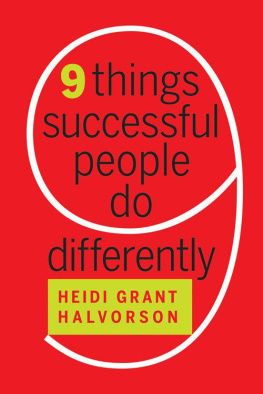Louis Cheskin - Why People Buy: Motivation Research and Its Successful Application
Here you can read online Louis Cheskin - Why People Buy: Motivation Research and Its Successful Application full text of the book (entire story) in english for free. Download pdf and epub, get meaning, cover and reviews about this ebook. year: 1959, publisher: Ig Publishing, genre: Art. Description of the work, (preface) as well as reviews are available. Best literature library LitArk.com created for fans of good reading and offers a wide selection of genres:
Romance novel
Science fiction
Adventure
Detective
Science
History
Home and family
Prose
Art
Politics
Computer
Non-fiction
Religion
Business
Children
Humor
Choose a favorite category and find really read worthwhile books. Enjoy immersion in the world of imagination, feel the emotions of the characters or learn something new for yourself, make an fascinating discovery.
- Book:Why People Buy: Motivation Research and Its Successful Application
- Author:
- Publisher:Ig Publishing
- Genre:
- Year:1959
- Rating:3 / 5
- Favourites:Add to favourites
- Your mark:
- 60
- 1
- 2
- 3
- 4
- 5
Why People Buy: Motivation Research and Its Successful Application: summary, description and annotation
We offer to read an annotation, description, summary or preface (depends on what the author of the book "Why People Buy: Motivation Research and Its Successful Application" wrote himself). If you haven't found the necessary information about the book — write in the comments, we will try to find it.
Why People Buy: Motivation Research and Its Successful Application — read online for free the complete book (whole text) full work
Below is the text of the book, divided by pages. System saving the place of the last page read, allows you to conveniently read the book "Why People Buy: Motivation Research and Its Successful Application" online for free, without having to search again every time where you left off. Put a bookmark, and you can go to the page where you finished reading at any time.
Font size:
Interval:
Bookmark:


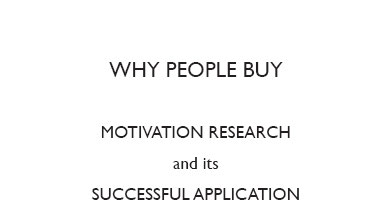
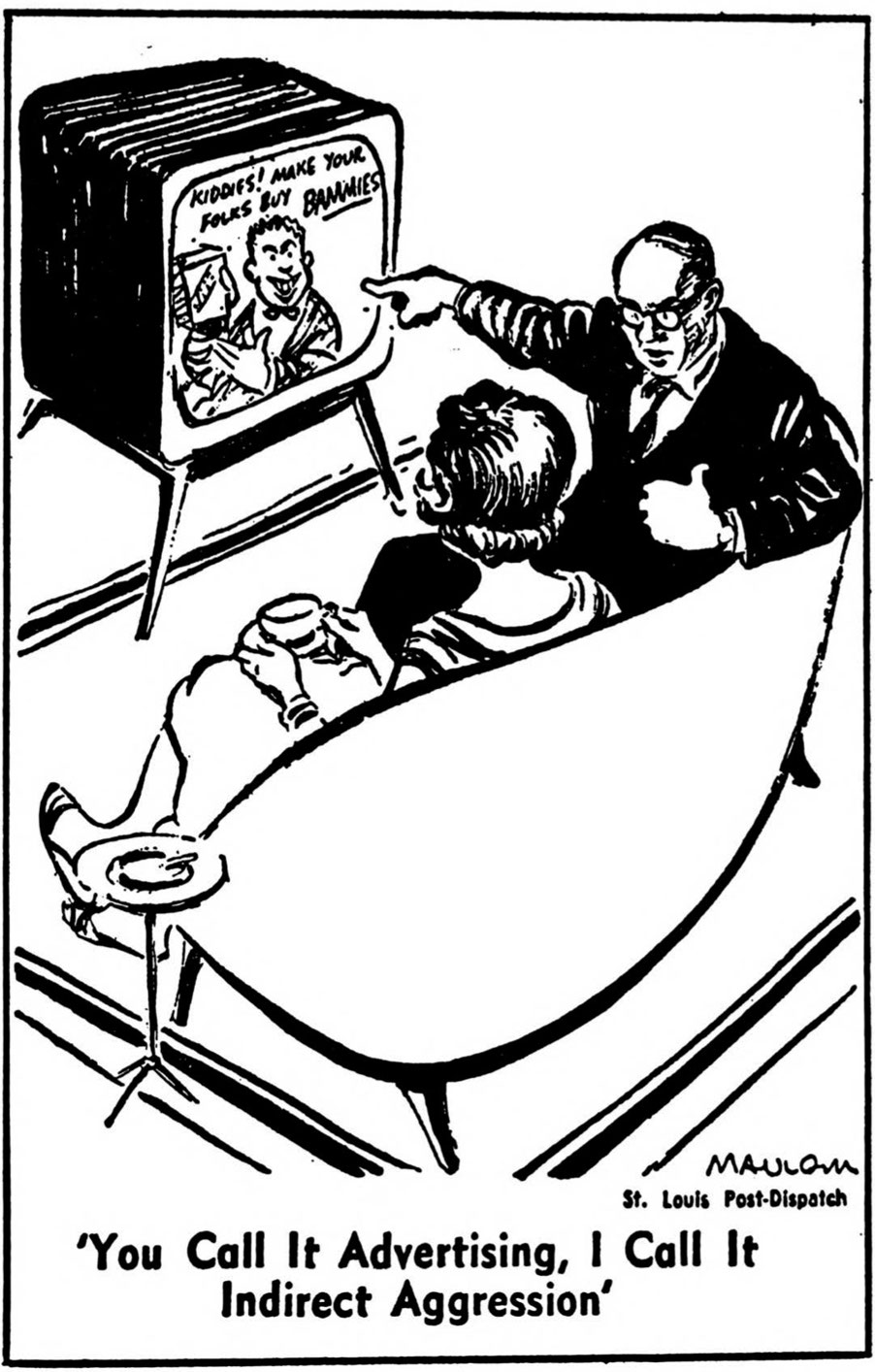
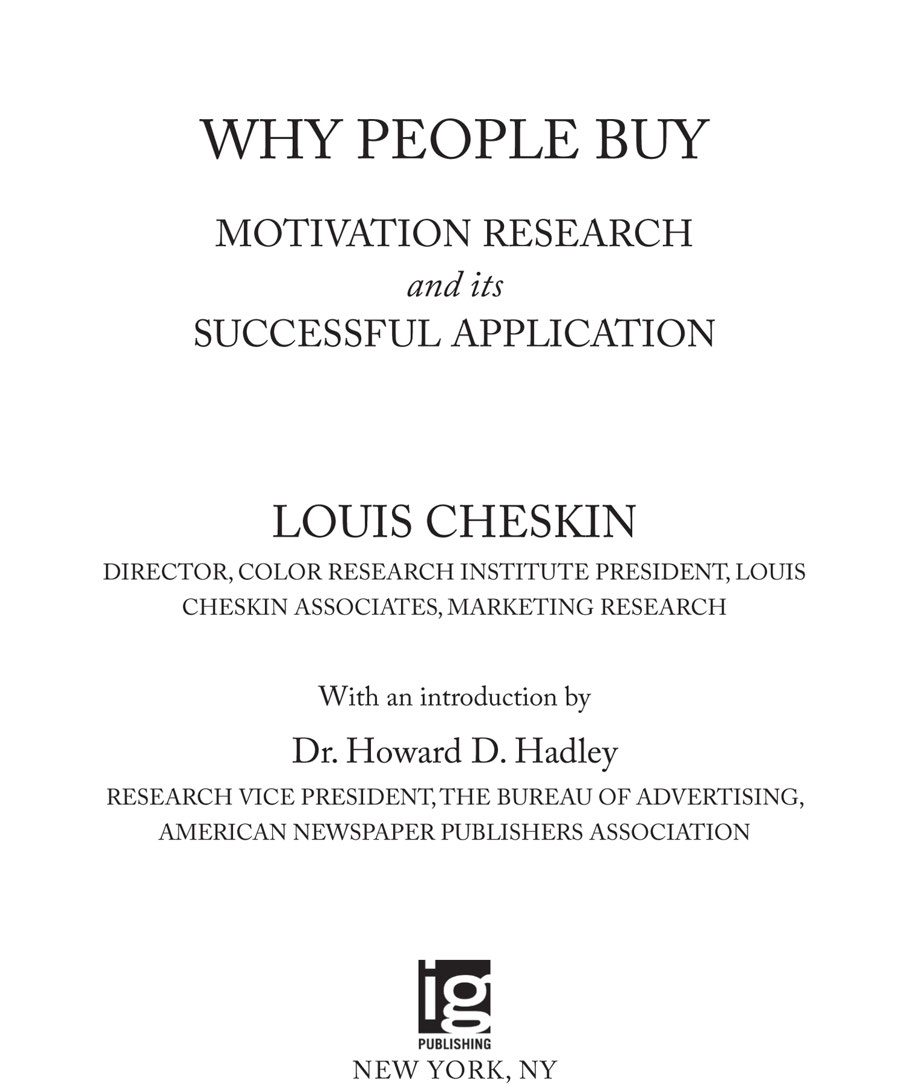
Copyright 1959 by Louis Cheskin. Copyright renewed 1987 by Louis Cheskin.
All rights reserved.
No part of this book may be used or reproduced in any manner without written permission of the publisher.
Please direct inquiries to:
Ig Publishing
Box 2547
New York, NY 10163
www.igpub.com
ISBN: 978-1-63246-033-2 (ebook)
I dedicate this book to
Charles W. H. Matthaxi
the man who has to make marketing decisions
We were trying to measure attitudes toward adult education, attitudes toward citizenship, social studies, traditional art and modern art.
In the field of predetermining how consumers will react to a new product or to an improvement of an old one, executive judgment is put to a great test. This is because the techniques used in determining consumer attitudes and in measuring consumer behavior in relation to the product are very complex. Some of the consumer reaction measuring methods are totally foreign to the business world.
Product quality is the number one side in a profitable marketing program, the package is the number two side, advertising is the number three side and pricing is number four. Actually, a marketing program depends on all four, equally. Weakness of any of the four sides will cut sales and diminish profits.
Often the image symbolizes the company as a whole and serves as the focal point of the entire company image. It performs as the hub of the company identity to the consumer and is a trademark that may have favorable or unfavorable connotations.
Several car designs should be parts of all tests merely as controls, as testing devices, not to be considered for actual production. This aspect is very important because it serves both as a control in the test situation, and as a means of keeping competition off the track. By conducting market tests on an unconscious level, by testing parts before finally testing complete car designs, and by including in these tests some designs as controls, we can get the answers for a car maker without revealing plans to competition.
The Sputniks made us more serious, more practical but not more rational. In 1958 I have seen more signs of psychological than of economic depression. The behavior of many still indicates a certain amount of desperation. The urging by some that we adopt communist methods in order to compete with Russia is irrational. The emphasis on physical science and willingness to neglect the humanities and the behavioral sciences in education is irrational. This irrational behavior, of course, was not predictable.
In order to find out what kind of label or package will motivate dog owners to buy a particular brand, we must conduct tests with controls. We must make sure that some factor outside of what is being tested, does not influence the respondents.
We can now hope to have non-irritating commercials on T.V., the kind that will be acceptable to theatre operators. We can anticipate such development in the advertising field because unconscious-level tests can be conducted to ascertain whether the public will react favorably toward the commercial and whether it will be effective in producing sales.
All of these research organizations, the pioneers and the imitators, have one thing in common. They all operate on the assumption that advertising is effective only on a conscious level, and that marketing is based on product familiarity. The great progress that has been made in the behavioral sciences in recent years is given no recognition. The findings of psychoanalysis are given no attention. The unconscious mind is given no consideration. Subconscious motivations are not measured.
The moment an individual is asked to judge and reveal his judgment, his defense mechanisms are immediately called into action. Ego-involvement and prestige identification immediately enter the test situation. Guards that operate both on conscious and unconscious levels take over the duties of protecting the ego and maintaining its privacy.
A physicist cannot predict the behavior of a single electron because the means he uses for observing or measuring its behavior changes its course. Therefore, he has to deal with great numbers of electrons in order to define their behavior. Human beings behave like electrons. A market researcher cannot predict the behavior of a single consumer because the means the researcher uses for observing or measuring the behavior often changes it. A market researcher has to deal with a great number of potential consumers in order to predict their pattern of behavior.
The average American male is not nearly as concerned with holding up his pants, as he is about showing that he owns a beautiful belt, or a rare, unusual, or costly one. Beauty, rarity, unusualness and costliness are status symbols. They are psychological and vital factors of prestige identification and are implements of his ego.
The tests of the Chevron-Crest image, by itself, and of the package as a whole, show clearly that the Chevron-Crest is a symbol people feel. They are deeply affected by it. But this symbol, like many emotionally significant symbols, people feel, is not a subject for discussion.
Before alert managers make any kind of marketing decision, they submit the problem to reliable marketing research. The following, although in part, is the actual report of how the managers of Nescaf proceeded with their examination of the logotype on the Nescaf label and the label as a whole.
The two tests showed clearly that Hawley & Hoops had a valuable property in the Uncle Bens Rice symbol and that the appetite appeal illustration was a great asset indeed. These are among the most remarkable test results of an old brand symbol we have ever seen.
On page 179, Table XXIVAttitudes Ranked shows an interesting picture of semantic contrasts. Note that higher price and better quality are at the top with the new design. Lower price and poorer flavor are at the top with the old label.
The name has a quantitative connotation. It has an image of quantity, not of quality. The product you describe needs a name that has quality connotations.
This report alone demonstrates that brand-identifying designs play major roles in marketing and that design details are vital factors in the success or failure of a marketing program.
The tests gave management a basis for making a marketing decision in regard to the package for a product of high quality.
Conducting Tests Nos. 2, 3 and 4 requires great know-how and many controls. These are not the kinds of tests that can be conducted by amateur researchers. Strictly controlled conditions must prevail in conducting such tests. Controls must be used in the design of the test, in the consumer sampling and in administering it. The indirect approach is vital. Traditional, direct testing methods are not applicable here.
Font size:
Interval:
Bookmark:
Similar books «Why People Buy: Motivation Research and Its Successful Application»
Look at similar books to Why People Buy: Motivation Research and Its Successful Application. We have selected literature similar in name and meaning in the hope of providing readers with more options to find new, interesting, not yet read works.
Discussion, reviews of the book Why People Buy: Motivation Research and Its Successful Application and just readers' own opinions. Leave your comments, write what you think about the work, its meaning or the main characters. Specify what exactly you liked and what you didn't like, and why you think so.

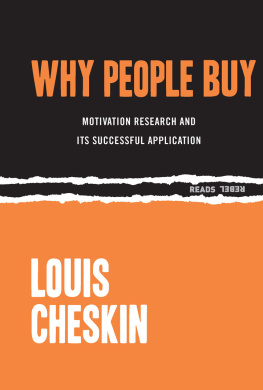




![Louis de Montfort - The Saint Louis de Montfort Collection [7 Books]](/uploads/posts/book/265822/thumbs/louis-de-montfort-the-saint-louis-de-montfort.jpg)




